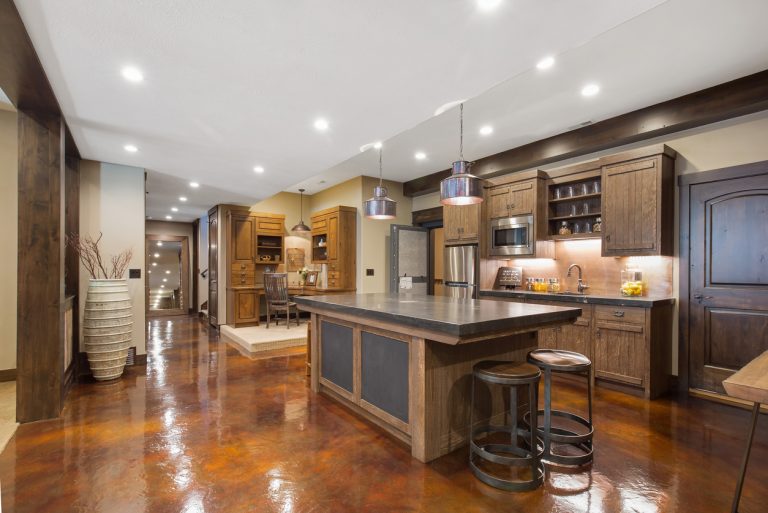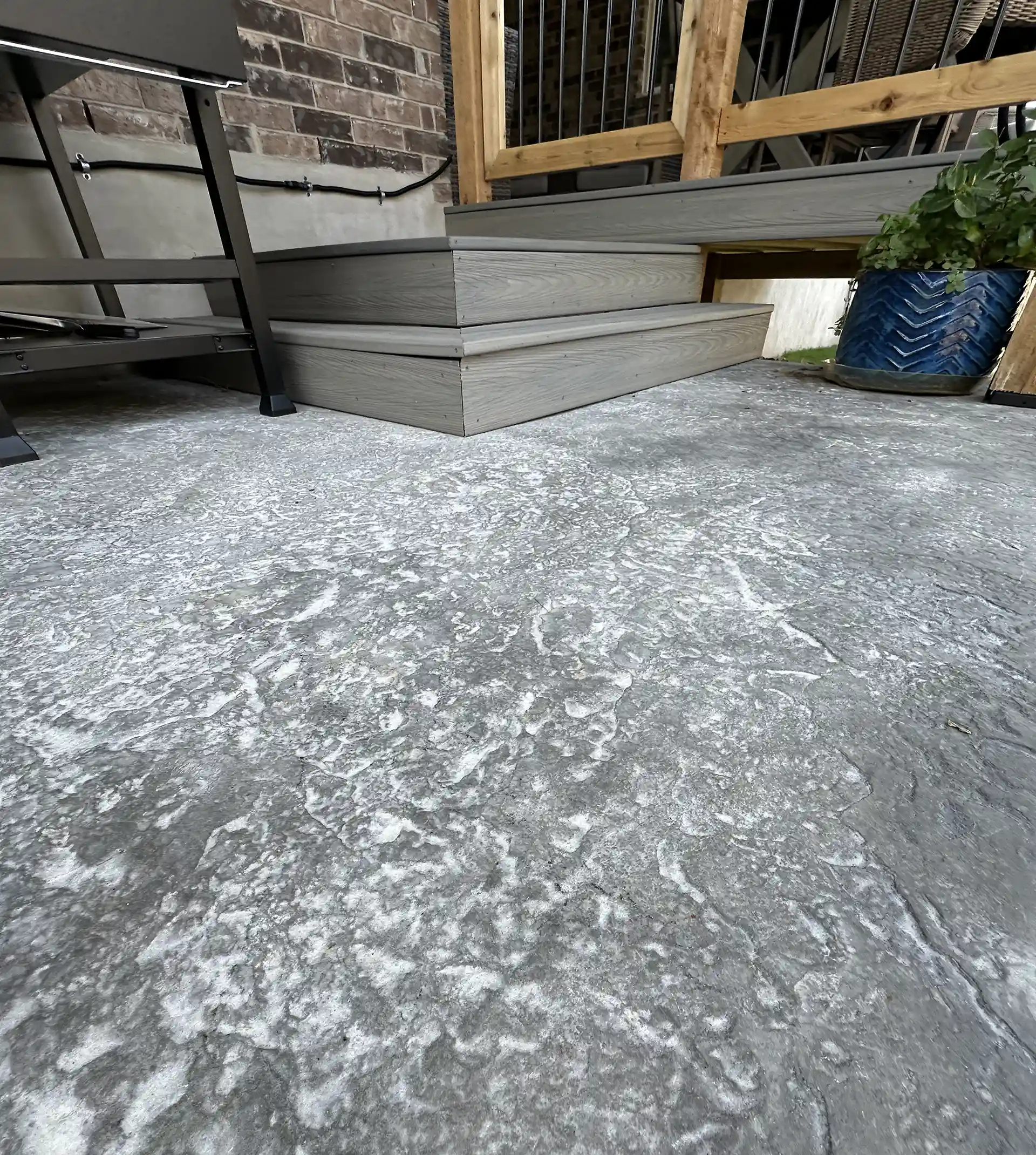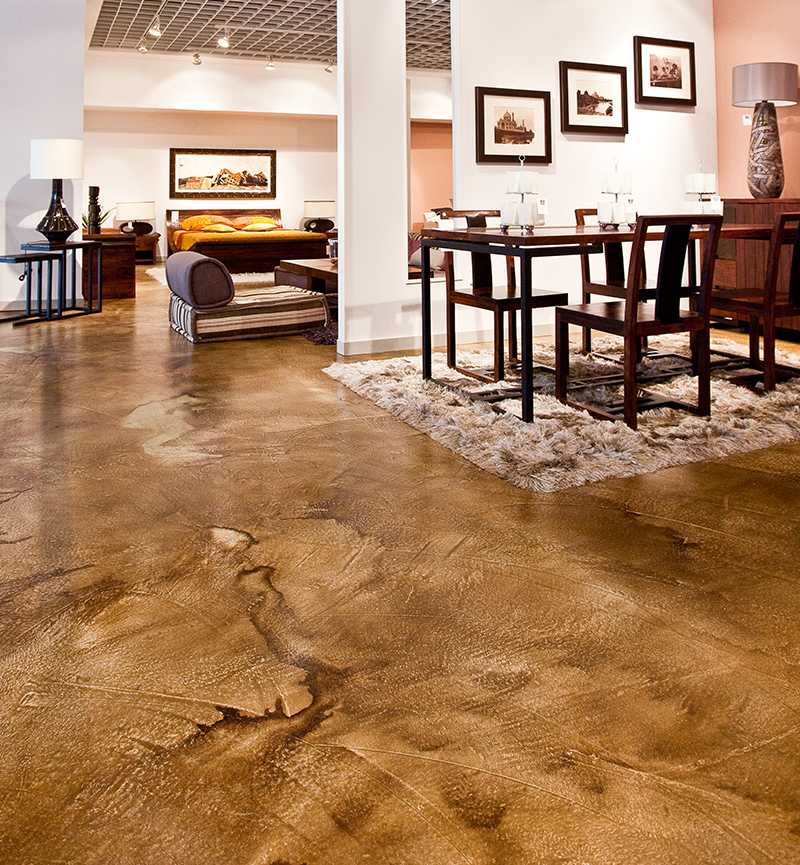10 tips for maintaining stained concrete floors for years to come
Comprehending the Variety Of Solutions Offered in Flooring: Highlighting Stained Concrete Techniques
Stained concrete has actually become a compelling flooring alternative for different spaces. Its versatility exists in the option between acid and water-based discolorations, each using unique appearances. Appropriate preparation and recurring maintenance are necessary to guarantee its durability and look. As the demand for cutting-edge floor covering services expands, comprehending the nuances of tarnished concrete methods could open brand-new opportunities for both property and industrial settings. What one-of-a-kind advantages might this flooring choice bring to a job?
The Basics of Stained Concrete
Stained concrete works as a functional flooring choice that combines longevity with visual appeal. This flooring strategy involves applying a particularly formulated stain to the concrete surface, which passes through and modifies the shade of the product. The procedure not only boosts the aesthetic aspects of concrete yet also uses the benefit of shielding it from wear and tear. Stained concrete can achieve a wide array of appearances, from earthy tones to vivid hues, making it appropriate for numerous style themes.
Correct prep work of the concrete surface area is crucial for perfect outcomes. This may include cleaning, grinding, or etching to ensure the stain adheres successfully. Additionally, the application procedure usually involves using tools such as sprayers or brushes to attain consistent coverage. After staining, a sealer is typically put on enhance sturdiness and preserve the vibrancy of the shade. Inevitably, tarnished concrete provides an attractive and resilient floor covering remedy for residential and industrial spaces alike.
Kinds of Stains: Acid vs. Water-Based

In contrast, water-based spots provide a bigger range of colors and are much easier to apply. They do not respond chemically with concrete yet instead offer a surface area tint - austin stained concrete service. Water-based discolorations are reduced in unpredictable organic compounds (VOCs), making them extra eco-friendly and ideal for indoor projects. While they may not supply the exact same deepness of shade as acid spots, their flexibility and simplicity of use make them appealing for various applications. Inevitably, the option depends upon the job's demands, preferred looks, and area
Strategies for Staining Concrete
The strategies for tarnishing concrete vary substantially in between acid and water-based techniques. Acid staining includes a chain reaction that creates special, variegated colors, while water-based stains offer a more comprehensive scheme and much easier application. Recognizing these procedures is crucial for achieving the desired visual in concrete floor covering.
Acid Staining Process
Acid staining offers a dynamic means to boost the visual appeal of concrete surfaces. This procedure includes applying a combination of water, hydrochloric acid, and pigments to the concrete, which responds chemically to generate dynamic, translucent shades. The concrete surface area should be thoroughly cleaned and prepped to guarantee ideal attachment. When used, the acid stain passes through the concrete, producing distinct marbled results as it reacts with the lime in the concrete. After the desired color creates, the surface is neutralized and rinsed to halt the response. Lastly, a sealant is put on secure the finish and boost longevity. Acid staining not only transforms the appearance of concrete however additionally supplies a lasting option for decorative floor covering.
Water-Based Staining Benefits
Just how can water-based staining elevate the visual and functional top qualities of concrete surfaces? Water-based discolorations supply a versatile solution for improving concrete, supplying lively shade choices while guaranteeing environmental security. Unlike acid spots, water-based alternatives penetrate the surface, allowing for also color distribution and a variety of surfaces, from matte to glossy. Additionally, they are low in unpredictable natural substances (VOCs), making them less unsafe to indoor air quality. Their fast drying out time promotes quicker task conclusion, while their resistance to fading guarantees resilient appeal. Water-based discolorations can also enhance the concrete's longevity and resistance to discolorations, making them an ideal selection for both property and business applications. Inevitably, they provide a sustainable, appealing option for numerous concrete surface areas.
Style Possibilities With Stained Concrete
Stained concrete offers a series of layout opportunities that can boost any space. Strategies such as color variant, different surface finishing alternatives, and customized design patterns permit one-of-a-kind and customized floor covering remedies. These components not just raise appearances but likewise add to the total performance of the concrete surface area.
Color Variation Methods
While discovering the style possibilities of stained concrete, color variant techniques play a pivotal duty in improving both visual allure and functionality. These techniques allow for the development of one-of-a-kind patterns and results that can change a simple concrete surface area into an aesthetically striking component of an area. Alternatives such as acid staining, which reacts chemically with the concrete, produce abundant, translucent colors that simulate all-natural stone. Water-based stains offer a broader color palette and enable more control in style. Moreover, layering various stains go to my site can create depth and dimension, giving a personalized appearance. By incorporating shade variation methods, developers can attain varied styles, from rustic to contemporary, Get More Info ensuring that discolored concrete fits perfectly into any type of style plan.
Surface Area Finishing Options
The exploration of color variation strategies sets the phase for taking into consideration surface area ending up alternatives, which considerably influence the general appearance and performance of stained concrete. Various surfaces can improve the visual allure and resilience of the surface area. Common choices consist of matte, satin, and shiny finishes, each giving an unique aesthetic result. Matte surfaces supply a subtle, underrated elegance, while satin coatings strike a balance between luster and practicality, making them prominent for residential and commercial rooms. Glossy coatings, on the other hand, develop a high-shine look, boosting shade vibrancy and light reflection. In addition, surface area therapies such as polishing or sealing better boost longevity, making these completing options important factors to consider in making practical and visually appealing discolored concrete floors.
Custom-made Layout Patterns
Exactly how can customized layout patterns raise the appeal of tarnished concrete? By integrating special layouts, discolored concrete can change regular floor covering into a striking visual declaration. Custom patterns, such as geometric shapes, elaborate concepts, or organic layouts, enable personalization, making areas feel customized and inviting. Clients can pick from a variety of strategies, including saw cuts, patterns, or overlays, to accomplish desired results. Additionally, incorporating multiple colors with various stain techniques boosts the depth and dimension of the patterns. These layout possibilities not just enhance visual appeal however also increase the value of residential or industrial spaces. Eventually, personalized style patterns provide a chance for creative thinking, setting discolored concrete in addition to typical floor covering options.
Preparing Your Concrete Surface
Appropriate prep work of the concrete surface area is vital for accomplishing an effective discolored finish. This process starts with extensive cleaning to get rid of dirt, oil, and any type of other impurities. A stress washing machine or a floor scrubber can efficiently get rid of these substances, guaranteeing a fresh start for staining. After cleansing, it is essential to fix any kind of fractures or imperfections in the concrete. This can be completed using a concrete patching compound, which must be permitted to heal fully prior to proceeding.
As soon as the surface is clean and repaired, grinding or fining sand may be necessary to develop a smooth, even appearance. This action improves the concrete's capability to take in the stain evenly. Finally, a concrete etcher can be put Learn More Here on open up the pores of the surface area, permitting much better adhesion of the stain (austin stained concrete service). By following these prep work steps, the resulting discolored concrete will show a much more dynamic and enduring surface
Maintenance and Care for Stained Concrete
Preserving stained concrete is important for preserving its appearance and long life after the initial prep work and application of stain. Routine cleaning is necessary; sweeping or vacuuming to remove dust and particles protects against scrapes and monotony. For much deeper cleaning, a moderate pH-neutral detergent blended with water can be made use of, adhered to by thorough rinsing to stay clear of deposit accumulation.
Sealing stained concrete is an additional vital upkeep step, as it protects the surface area from discolorations and wetness. Depending upon the sealer kind, reapplication may be required every one to 3 years. Furthermore, avoiding extreme chemicals and rough tools aids preserve the integrity of the stain.
For outside discolored concrete, it is recommended to clear snow or ice promptly to stop damages from freeze-thaw cycles. In general, regular treatment guarantees that tarnished concrete keeps its vibrant shade and structural security in time, making it a lasting flooring selection.

Expense Factors To Consider for Stained Concrete Floor Covering
When examining the price of tarnished concrete floor covering, possible home owners frequently wonder about the various factors that influence pricing. Key considerations include the dimension of the location to be covered, the intricacy of the style, and the kind of stain made use of. Standard staining strategies often tend to be a lot more affordable, while intricate patterns or multiple shades can greatly enhance costs.

Geographic area is one more factor, as costs can differ widely from one area to another. Ongoing maintenance costs should be factored in, as sealants and safety coatings may be necessary over time to preserve the visual and longevity of the tarnished concrete.
Frequently Asked Inquiries
Can Stained Concrete Be Applied Over Existing Flooring?
The concern of whether discolored concrete can be applied over existing floor covering is typically asked. Typically, it is feasible, offered the underlying surface is tidy, stable, and appropriate for proper adhesion of the discolored concrete.
How Lengthy Does the Staining Process Take?
The staining process generally takes a couple of hours to a full day, relying on the size of the area and the intricacy of the style. Healing may call for additional time prior to the surface area is fully useful.
Is Stained Concrete Suitable for Outdoor Use?
Stained concrete is undoubtedly ideal for outdoor use, as it holds up against various climate condition. Its longevity and aesthetic charm make it a preferred choice for outdoor patios, sidewalks, and driveways, enhancing both functionality and visual passion.
Can I Change the Color of Stained Concrete Later?
The capability to transform the shade of stained concrete later depends upon different variables, consisting of the original stain type and surface preparation. Consulting an expert can supply advice on prospective choices and results for color modification.
Are There Eco-Friendly Options for Stained Concrete?
The questions concerning environmentally friendly options for stained concrete reveals an expanding passion in lasting structure techniques. Lots of business now offer low-VOC stains and eco-friendly sealants, ensuring visual appeal while lessening environmental impact.